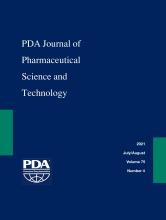Abstract
This article details a risk-based methodology designed to assign environmental classifications to the different operations in biopharmaceutical facilities manufacturing non-sterile (low bioburden) drug substance. Generally, environmental conditions for active pharmaceutical ingredient manufacture are established based on previous experiences or expectations or on extrapolated interpretations of current good manufacturing practices guidelines. Improvements in equipment design and operation, especially the use of closed systems, allow certain process steps to take place in controlled environment areas rather than in classified clean rooms. However, the design of facilities has not developed to reflect these technological advancements. The result is that facility designs are more complex with multiple environmental classifications, resulting in far higher capital and operational costs than necessary given the current technology and understanding. The authors propose a formal risk assessment-based methodology that is applicable in the early design phase of new facilities and facilitates the fast selection of the environmental conditions required for the different process steps. The risk assessment describes the risk to product quality or patient safety from environmental contamination, and this is expressed in terms of impact, probability, and detectability. The assessment considers growth potential in terms of time, nutrients, and temperature; bioburden limit; level of closure of the system; and the ability of the process to detect contamination to assign an environmental classification. Because closure is a key factor in the methodology, the authors propose a practical definition of closed systems, building on existing International Society for Pharmaceutical Engineering guidance. A fundamental of the assessment is that closed system operations only require controlled not classified environments, and any increase in classification does nothing further to protect the product. Results of the assessment are discussed in relation to a variety of process steps in different operating scenarios, to demonstrate how the assessment is applied. The methodology strongly supports the implementation of closed systems and demonstrates the limited need for classified areas. With fewer classified rooms, companies can reduce the complexity of facility layout and save costs without compromising patient safety or product quality.
- Risk-based
- Closed systems
- Closed process
- Room classification
- Environmental classification
- Biopharmaceuticals
- Low bioburden
- Drug substance manufacture
- Facility design
- © PDA, Inc. 2021
PDA members receive access to all articles published in the current year and previous volume year. Institutional subscribers received access to all content. Log in below to receive access to this article if you are either of these.
If you are neither or you are a PDA member trying to access an article outside of your membership license, then you must purchase access to this article (below). If you do not have a username or password for JPST, you will be required to create an account prior to purchasing.
Full issue PDFs are for PDA members only.
Note to pda.org users
The PDA and PDA bookstore websites (www.pda.org and www.pda.org/bookstore) are separate websites from the PDA JPST website. When you first join PDA, your initial UserID and Password are sent to HighWirePress to create your PDA JPST account. Subsequent UserrID and Password changes required at the PDA websites will not pass on to PDA JPST and vice versa. If you forget your PDA JPST UserID and/or Password, you can request help to retrieve UserID and reset Password below.






